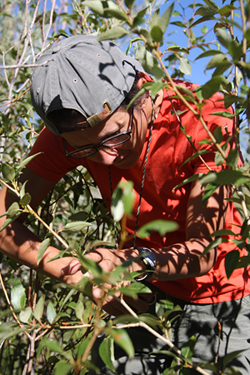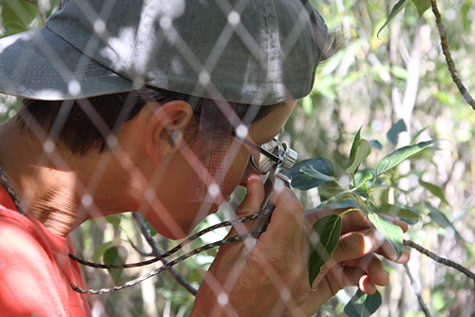

This post was written by Nick Neely, 2010 Birding Intern.
Last week, I followed Sacha Heath down the Lee Vining Creek trail (and across the frigid stream, in my sneakers) to help count Lilliputians that live in trees. Sacha directed the Point Reyes Bird Observatory research in the Mono Basin for many years, but this season, for her Master’s thesis at Humboldt State University, she’s studying the impact foraging birds have on populations of herbivorous arthropods—i.e. plant-munching bugs—in cottonwoods. Bugs affect the growth of trees, of course, and Sacha picked the Mono Basin as her research location not only because she has an unparalleled knowledge of its riparian communities, but also because it’s a restoration setting—here, new growth is at a premium. The goal of the study is to assess ‘”the ecological service” birds likely provide.
Early in the spring, Sacha braved the snow along Mill and Lee Vining creeks to set up “exclosures”—cubes made of PVC pipe wrapped with fine netting—that keep birds out of young cottonwoods. Each exclosed tree is paired with a similarly-sized, nearby “control” tree (or uncontrolled, as the case may be), to allow for easy comparison. Now, at summer’s end, we’d come to survey the trees. While I sat with a clipboard in the dappled shade of willow or cottonwood, Sacha dexterously craned her neck and slender arms in and out of her small sample trees—“sa(m)plings,” maybe?—being careful not to jostle them unnecessarily. To my more or less idle-eye, she looked like a jewel thief, taking pains not to trip up a wire or invisible laser beam, or a performer inside the conceptual installation of her design.

Indeed, Sacha plainly demonstrated the art inherent in all ecology as she systematically, but gracefully, worked her way around, and up, each tree. Along the way, she counted each and every leaf (with a silver ticker, the kind used to count the attendance at sporting event), glanced at its light-colored underside, and announced any critters she discovered. My job was to record and confirm her observations with a punctual echo. I tried to keep it cheery:
“One striped thrips.”
“A striiiiped thrips!”
“One—no, make that three—pucker galls.”
“Threeee pucker galls.”
Not to be confused with a petiole gall.
“Two half-leaf folds without silk.”
What’s that? Imagine the edge of a leaf curled over, gracefully, like a breaker nearing shore, and, inside its green pipe, a little larva, hanging loose.
“Two without silk!”
It felt a bit like repeating orders back to customers at a burger joint: Right, no onions on that bug, or, Five groups of leaf aphids, 170 individuals total—order up! But Sacha did all the serving—all the hard, peering work—and much of what she noticed the untrained eye might miss to start. When I began to look, however, bugs—or their shelters, such as galls or “leaf folds”—started to appear before me in abundance (an example of what author Michael Pollan calls “the pop-out effect”). In the Mono Basin, even on a runty cottonwood no taller than your shoulder there are diptera midges, lacewing pupae, an occasional coleoptera (beetle), not to mention many, many ants (some “tending” aphids—shepherding them, essentially, for their sweet secretions).
The project’s data is still out—or rather, uncrunched. But anecdotally, Sacha is finding that, yes, there may be more bugs on her captive cottonwoods, though it varies from pair of trees to pair of trees. She also senses that the exclosures’ effects are most striking in the greenest, most biologically productive reaches of the creeks, and that conspicuous, delectable bugs, like large caterpillars, have the biggest reason to be thankful (they’ll be out of luck next year). Meanwhile, another student who visited the basin this summer to help Sacha with the project discovered that, in the exclosures, bugs were distributed throughout the tree—on the tips of branches, free of worry—while they tended to cling tighter, if not fearfully, to the trunk of exposed sa(m)plings.
There may be hundreds of bugs on each sa(m)pling, but there are thousands of leaves. Sacha counted over 10,000 between four trees during the five hours I volunteered—a lot of ticks on the counter. Then as we hiked back to town, Sacha confessed that one of her sa(m)plings, up next to be surveyed, had that many leaves alone. Phew. I pitied (but also partly envied) my replacement.
